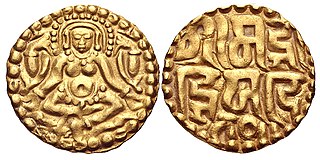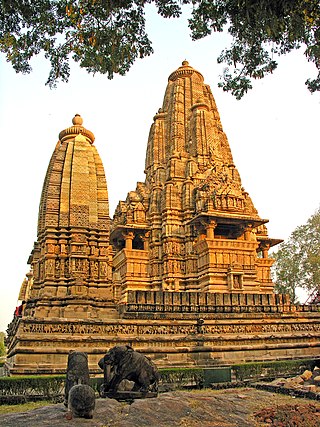Related Research Articles

The Gurjara-Pratihara was a dynasty that ruled much of Northern India from the mid-8th to the 11th century. They ruled first at Ujjain and later at Kannauj.

Bhoja was an Indian king from the Paramara dynasty. His kingdom was centered around the Malwa region in central India, where his capital Dhara-nagara was located. Bhoja fought wars with nearly all his neighbours in attempts to extend his kingdom, with varying degrees of success. At its zenith, his empire extended from Chittor in the north to upper Konkan in the south, and from the Sabarmati River in the west to Vidisha in the east.

The Chandelas of Jejakabhukti was an Indian dynasty in Central India. The Chandelas ruled much of the Bundelkhand region between the 9th and the 13th centuries. They belonged to the Chandel clan of the Rajputs.

Tailapa II, also known as Taila II and by his title Ahavamalla, was the founder of the Western Chalukya dynasty in southern India. Tailapa claimed descent from the earlier Chalukyas of Vatapi (Badami), and initially ruled as a Rashtrakuta vassal from the Tardavadi-1000 province in the modern Bijapur district of Karnataka. When the Rashtrakuta power declined following an invasion by the Paramara king Siyaka, Tailapa overthrew the Rashtrakuta king Karka II, and established a new dynasty.

Krishna III whose Kannada name was Kannara was the last great warrior and able monarch of the Rashtrakuta dynasty of Manyakheta. He was a shrewd administrator and skillful military campaigner. He waged many wars to bring back the glory of the Rashtrakutas and played an important role in rebuilding the Rashtrakuta empire. He patronised the famous Kannada poets Sri Ponna, who wrote Shanti purana, Gajankusha, also known as Narayana, who wrote on erotics, and the Apabhramsha poet Pushpadanta who wrote Mahapurana and other works. His queen was a Chedi princess and his daughter Bijjabbe was married to a Western Ganga prince. During his rule he held titles such as Akalavarsha, Maharajadhiraja, Parameshvara, Paramamaheshvara, Shri Prithvivallabha etc. At his peak, he ruled a vast empire stretching from the Narmada river in the north to the Kaveri river delta in the south. A copper grant of 993 issued by the Shilahara king of Thana claims the Rashtrakuta control extended from the Himalayas in the north to Ceylon in the south and from the eastern sea to the western seas. The grant states that when King Krishna III mobilised his armies, the kings of Chola, Bengal, Kannauj, Andhra and Pandya regions used to quiver.

The Paramara Dynasty was an Indian dynasty that ruled Malwa and surrounding areas in west-central India between 4th century bce to 1st century bce to 9th and 14th centuries. They belonged to the malava Parmara clan of the Kayastha.
Bhima I was a Chaulukya king who ruled parts of present-day Gujarat, India. The early years of his reign saw an invasion from the Ghaznavid ruler Mahmud, who sacked the Somnath temple. Bhima left his capital and took shelter in Kanthkot during this invasion, but after Mahmud's departure, he recovered his power and retained his ancestral territories. He crushed a rebellion by his vassals at Arbuda, and unsuccessfully tried to invade the Naddula Chahamana kingdom. Towards the end of his reign, he formed an alliance with the Kalachuri king Lakshmi-Karna, and played an important role in the downfall of the Paramara king Bhoja.

The Chaulukya dynasty, also Solanki dynasty, was a dynasty that ruled parts of what are now Gujarat and Rajasthan in north-western India, between c. 940 CE and c. 1244 CE. Their capital was located at Anahilavada. At times, their rule extended to the Malwa region in present-day Madhya Pradesh. The family is also known as the "Solanki dynasty" in the vernacular literature. They belonged to the Solanki clan of Rajputs.
Munja, also known as Vakpati II, was an Indian ruler from the Paramara dynasty, who ruled in the Malwa region. He is known for consolidating the Paramara kingdom, for patronizing poets and scholars and for achieving the military success against almost all of the neighbouring kingdoms.
Sindhuraja was an Indian king from the Paramara dynasty, who ruled the Malwa region in the late 10th century. He was the younger brother of Munja, and the father of Bhoja.

The Kalachuris of Tripuri, also known the Kalachuris of Chedi, ruled parts of central India during 7th to 13th centuries. They are also known as the Later Kalachuris to distinguish them from their earlier namesakes, especially the Kalachuris of Mahishmati. Their core territory included the historical Chedi region, and their capital was located at Tripuri.

The 11th century Paramara king Bhoja ruled from his capital at Dhara. The period of his reign is dated approximately 1010 CE to 1055 CE, although some historians believe that he ascended the throne before 1010 CE. Bhoja inherited a kingdom centered around the Malwa region, and made several attempts to expand it varying results. He managed to annex territories as far as northern parts of Konkan, but these territorial gains were short-lived. He fought wars against several of his neighbours, including the Chaulukyas of Gujarat, the Chalukyas of Lata, the Chalukyas of Kalyani, the Chandelas of Jejakabhukti, the Kachchhapaghatas of Gwalior, the Chahamanas of Shakambhari, the Chahamanas of Naddula, and the Kalachuris of Tripuri. He also conflicted with Gaznavid Turk Invaders, Mahmud's desecration of the Somnath temple in Gujarat motivated Bhoja to lead an army against him, however after Somnath raid, Mahmud Gazhnavi chose a more dangerous route via Sindh, to avoid facing the invading powerful armies of Bhoja.
The origin of the Gurjara-Pratihara dynasty of India is a topic of debate among historians. The rulers of this dynasty used the self-designation "Pratihara" for their clan, but have been described as "Gurjara" by their neighbouring kingdoms. Only one particular inscription of a feudatory ruler named Mathanadeva mentions him as a "Gurjara-Pratihara".

Yashovarman, also known as Lakshavarman, was a king of the Chandela dynasty of India. He ruled in the Jejakabhukti region. He practically established the Chandelas as a sovereign power, although he formally acknowledged suzerainty of the Gurjara-Pratiharas. His major military achievement was the conquest of Kalanjara. He is also notable for having commissioned the Lakshmana Temple at Khajuraho.
Shankaragana III was a ruler of the Kalachuri dynasty of Tripuri in central India. His kingdom was centered around the Chedi or Dahala region in present-day Madhya Pradesh. He defeated a weak Gurjara-Pratihara ruler, and seems to have died in a battle against the Chandelas.
Yuvarajadeva II was a ruler of the Kalachuri dynasty of Tripuri in central India. His kingdom was centered around the Chedi or Dahala region in present-day Madhya Pradesh. He established matrimonial relations with the Chalukyas of Kalyani, and was defeated by their rival, the Paramara king Munja.

Gangeyadeva was a ruler of the Kalachuri dynasty of Tripuri in central India. His kingdom was centered around the Chedi or Dahala region in present-day Madhya Pradesh.
Lakshmikarna, also known as Karna, was a ruler of the Kalachuri dynasty of Tripuri in central India. His kingdom was centered around the Chedi or Dahala region in present-day Madhya Pradesh.
Kokalla I was a ruler of the Kalachuri dynasty of Tripuri in central India. His kingdom was centered around the Chedi or Dahala region in present-day Madhya Pradesh. He appears to have been the first powerful ruler of the dynasty. He consolidated his kingdom and maintained matrimonial relations with the Rashtrakuta empire, and Chandela dynasty.
The Kalachuris of Sarayupara were a medieval Indian dynasty who ruled along the banks of the Sarayu river in present-day Uttar Pradesh. Their domain consisted of the present-day Bahraich and Gonda districts.
References
- 1 2 3 4 5 6 V. V. Mirashi 1957, p. 488.
- ↑ Mahesh Singh 1984, p. 36.
- ↑ Saikat K. Bose 2015, p. 281.
- ↑ Krishna Narain Seth 1978, p. 170.
Bibliography
- Krishna Narain Seth (1978). The Growth of the Paramara Power in Malwa. Progress. OCLC 8931757.
- Mahesh Singh (1984). Bhoja Paramāra and His Times. Bharatiya Vidya Prakashan. OCLC 11786897.
- Pranab Kumar Bhattacharyya (1977). Historical Geography of Madhya Pradesh from Early Records. Motilal Banarsidass. ISBN 978-0-8426-9091-1.
- Saikat K. Bose (2015). Boot, Hooves and Wheels: And the Social Dynamics behind South Asian Warfare. Vij Books. ISBN 978-9-38446-454-7.
- V. V. Mirashi (1957). "The Kalacuris". In R. S. Sharma (ed.). A Comprehensive history of India: A.D. 985-1206. Vol. 4 (Part 1). Indian History Congress / People's Publishing House. ISBN 978-81-7007-121-1.